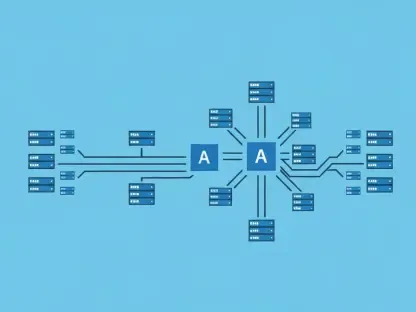In an era where cyber threats are becoming increasingly sophisticated, financial organizations are under immense pressure to bolster their cyber resilience. Despite advancements in cybersecurity tools and infrastructure, many institutions are still grappling with practices that could undermine their ability to withstand and recover from cyberattacks by 2025. This issue is paramount, as the financial sector remains one of the most targeted industries for cyber threats, necessitating a proactive and forward-looking approach to cybersecurity strategy.
Historical Silos and Blinkered Thinking
The Impact of Siloed Operations
One of the most significant challenges facing financial organizations is the deeply ingrained silos between security and operations teams. This separation often results in slower, less effective responses to cyber crises. When these teams fail to collaborate effectively, the organization as a whole suffers, leading to prolonged downtime and increased vulnerability to attacks. The lack of a unified approach hinders swift decision-making and the mobilization of resources, making it difficult to mount an effective defense or recovery during a cyber incident. Such structural inefficiencies are detrimental in an environment where speed and agility are crucial.
This division is further compounded by the differing priorities and objectives of these teams. Security teams are often focused on preventing breaches and safeguarding data, while operations teams prioritize maintaining system uptime and performance. This misalignment can lead to friction and a lack of coordinated efforts in securing the organization’s infrastructure. Bridging these gaps requires not just technological solutions but a cultural shift towards integrated team functions and shared responsibilities.
Narrow-Minded Approaches
Coupled with siloed operations is a narrow-minded approach to cybersecurity. Many organizations focus solely on their immediate responsibilities, neglecting the broader picture. This blinkered thinking prevents the development of comprehensive strategies that address the multifaceted nature of cyber threats, leaving organizations ill-prepared for complex attacks. Often, there is an overreliance on reactive measures rather than proactive strategies that can anticipate and mitigate risks before they escalate. This approach is insufficient in a landscape where cyber threats are continually evolving in sophistication and scale.
A more holistic approach to cybersecurity involves understanding the interconnected nature of threats and preparing integrated responses. Developing this broader perspective requires fostering a culture of continuous learning and adaptation. Financial institutions must invest in regular training, simulations, and the adoption of innovative technologies that enable them to stay ahead of adversaries. Only by broadening their strategic focus can these organizations hope to enhance their resilience and capability to respond to the increasingly complex threat landscape.
Advancements in Backup Infrastructure Security
Progress in Backup Security
There has been notable progress in the security of backup infrastructures, with features like immutable storage becoming standard. These advancements are crucial in protecting data from sophisticated adversaries who aim to corrupt or delete backups during an attack. Immutability ensures that once data is written, it cannot be altered or deleted, providing a verifiable and reliable source for recovery efforts. However, these improvements alone are not enough to ensure cyber resilience. Organizations must complement these technological advancements with robust processes and comprehensive security protocols that encompass all aspects of their digital operations.
Additionally, while immutable storage is a significant advancement, financial organizations must ensure that their backup strategies are well-integrated into their overall cybersecurity framework. This integration involves regularly testing backup systems to ensure they work as intended during an actual cyber crisis. It also requires the creation of detailed response plans that outline the steps to be taken when data recovery is necessary. These practices can help mitigate the damage caused by cyberattacks, ensuring that organizations can recover quickly and efficiently.
Zero-Trust Principles
The adoption of zero-trust principles is another promising development in cybersecurity. By assuming that every user and device is a potential threat, organizations can implement stricter access controls and continuously monitor for suspicious activity. This approach helps protect critical infrastructures, but it must be complemented by robust processes and integrations to be truly effective. Zero-trust security frameworks require an ongoing commitment to understanding and managing the myriad of devices and users that have access to an organization’s network. This entails deploying advanced monitoring tools, conducting regular security assessments, and enforcing strict identity verification processes.
However, the successful implementation of zero-trust principles extends beyond mere technological measures. It necessitates creating an organizational culture that prioritizes security at every level, from executive leadership to individual employees. This culture shift involves continuous education and training programs to ensure that all members of the organization are aware of and adhere to security protocols. By fostering a zero-trust mindset, financial institutions can significantly enhance their resilience against cyber threats, ensuring that they are better prepared to defend against and recover from potential attacks.
Inadequate Integration of Processes and Shared Responsibilities
The Need for Integrated Processes
Despite the advancements in cybersecurity tools, many financial organizations fail to develop the necessary processes and integrations to manage widespread cyberattacks effectively. This lack of integration often results in severe impacts from ransomware attacks, even for companies heavily invested in advanced cybersecurity measures. Efficient cyber resilience requires organizations to have streamlined processes that can quickly identify, contain, and mitigate threats. This involves not just having the right tools but also ensuring seamless coordination among various teams and departments.
Effective integration of processes includes the creation of detailed incident response plans that outline clear protocols for addressing cyber threats. These plans should be regularly updated and rehearsed through simulations and drills to ensure readiness in the event of an actual attack. Additionally, organizations must invest in automated systems that can rapidly detect and respond to anomalies, reducing the reliance on manual interventions which can be time-consuming and error-prone. By developing integrated processes, financial institutions can significantly enhance their ability to withstand and recover from cyber incidents.
Shared Responsibilities
Effective cyber resilience requires shared responsibilities across the organization. Security and operations teams must work together to develop and implement comprehensive strategies. Without this collaboration, organizations will continue to struggle with fragmented responses to cyber threats, undermining their overall resilience. Shared responsibilities mean that security is viewed as a collective goal rather than a siloed function. Each department and individual within the organization should understand their role in maintaining and enhancing cybersecurity. This collaborative approach can significantly enhance an organization’s ability to respond to and recover from cyber threats.
To foster this sense of shared responsibility, organizations should implement cross-functional teams that bring together members from various departments, including IT, security, operations, and risk management. These teams can work on developing and overseeing cybersecurity strategies, ensuring that all perspectives are considered and that a unified approach is adopted. Regular communication and collaboration are also essential, with frequent updates and briefings to ensure that everyone is aware of the current threat landscape and the organization’s strategies for mitigation and response. By promoting shared responsibilities and collaboration, financial institutions can strengthen their cyber resilience and better protect themselves against potential attacks.
Misclassification of Cyber Incidents as BC/DR Issues
The Pitfalls of Misclassification
Financial organizations often mistakenly consider cyber incidents as mere business continuity and disaster recovery (BC/DR) issues. This misclassification leads to isolated approaches by IT teams, who may not fully understand the evolving nature of cyber threats. As a result, critical input from security teams is often missing, leading to inadequate responses. Viewing cyber incidents through the narrow lens of BC/DR downplays the complexity and dynamic nature of modern cyber threats. This approach risks oversimplifying the organization’s response strategies, thus failing to address the root causes and broader implications of such incidents.
This narrow view hinders the development of comprehensive cybersecurity strategies that encompass prevention, detection, response, and recovery. It also reduces the opportunity for cross-departmental collaboration, as IT teams may attempt to address issues in isolation without valuable insights from security professionals. To avoid these pitfalls, financial institutions must recognize the distinct nature of cyber threats and develop specialized response plans that integrate the expertise of both IT and security teams. This cross-functional approach ensures that all aspects of a cyber incident are adequately addressed.
The Multifaceted Nature of Cyber Threats
Cyber threats are constantly evolving, and they require a multifaceted approach to address effectively. By viewing cyber incidents through the narrow lens of BC/DR, organizations miss the opportunity to develop comprehensive strategies that encompass prevention, detection, and response. This oversight can have severe consequences, leaving organizations vulnerable to repeated attacks. A nuanced understanding of the threat landscape involves recognizing that cyber incidents can impact various dimensions of the organization, from operational disruptions to reputational damage and regulatory compliance issues.
To effectively combat these threats, financial institutions must implement a holistic cybersecurity framework that integrates various disciplines, including threat intelligence, incident response, and risk management. This framework should prioritize proactive measures, such as regular security assessments, vulnerability management, and advanced threat detection capabilities. By adopting a multifaceted approach, organizations can better anticipate and mitigate the impact of cyber threats, ensuring a more resilient posture against future attacks.
Misguided Recovery Approach
The Flaw in Rushed Recoveries
One of the critical missteps highlighted in the article is the tendency to rush into mass recovery of IT systems without thoroughly investigating the root cause and mechanisms of the attack. This rushed approach often leaves organizations vulnerable to repeated attacks, as they fail to address the underlying issues that led to the initial breach. Beginning recovery efforts without a comprehensive understanding of the attack can result in overlooking critical vulnerabilities that adversaries can exploit again. This cycle not only wastes valuable resources but also undermines the organization’s long-term resilience.
A rushed recovery often prioritizes getting systems back online as quickly as possible, but this can be counterproductive if it results in the recurrence of the same issues. It is essential for organizations to approach recovery methodically, ensuring that they have thoroughly investigated the incident and fully understood its implications. This includes identifying the attack vectors, understanding the adversary’s tactics, techniques, and procedures (TTPs), and implementing measures to close any identified security gaps. By adopting a more deliberate approach to recovery, organizations can enhance their resilience and prevent similar incidents in the future.
The Importance of Thorough Investigation
A thorough investigation of cyber incidents is essential to understand the attack’s root cause and mechanisms. By taking the time to investigate, organizations can develop more effective recovery strategies that address the underlying vulnerabilities. This approach not only prevents repeated attacks but also ensures a more resilient posture against future threats. Conducting a comprehensive investigation involves gathering and analyzing evidence from various sources, including logs, network traffic, and endpoint data, to reconstruct the attack timeline and understand the adversary’s methods.
The insights gained from these investigations can inform the development of more robust security measures and response plans. This includes updating security policies, implementing new technologies, and conducting training programs to address identified weaknesses. Furthermore, sharing the findings with relevant stakeholders, including executive leadership and regulatory bodies, can help build a culture of transparency and continuous improvement. By prioritizing thorough investigations, financial institutions can strengthen their defenses and enhance their overall cyber resilience.
Lack of Collaboration and Communication
The Role of Collaboration in Cyber Resilience
Efficient collaboration between operations and security teams is crucial during major IT crises. When these teams work closely together, they can significantly reduce downtime and revenue loss associated with cyber incidents. However, many organizations still lack this level of collaboration, leading to fragmented and ineffective responses. The absence of a unified response strategy can result in confusion, delayed decision-making, and inefficient resource utilization, all of which can exacerbate the impact of a cyber incident.
To improve collaboration, financial organizations must foster a culture of teamwork and open communication. This involves breaking down silos and encouraging regular interactions between security and operations teams. Joint training sessions, simulations, and post-incident reviews can help build mutual understanding and trust, ensuring that both teams are aligned in their objectives and strategies. Additionally, implementing collaborative tools and platforms can facilitate real-time information sharing and coordination, enabling a more cohesive and effective response to cyber threats.
Enhancing Communication
Effective communication is another critical component of cyber resilience. Organizations must maintain systems that facilitate investigation, mitigation, recovery, and compliance with regulatory requirements. Without these systems, incident response efforts are hampered, leading to prolonged downtime and increased vulnerability. Communication plans should clearly define roles and responsibilities, establish protocols for information sharing, and ensure that all relevant stakeholders are kept informed throughout the incident lifecycle. This includes internal communication with employees and management, as well as external communication with customers, partners, and regulatory bodies.
Enhanced communication also involves investing in technologies that support secure and efficient information exchange. This includes encrypted communication channels, collaboration platforms, and incident management systems that provide a centralized view of ongoing activities and threat intelligence. By improving communication, financial institutions can ensure a more coordinated and effective response to cyber incidents, minimizing the impact on their operations and reputation.
Underestimating Ransomware Impacts in Simulations
The Limitations of Desktop Simulations
Financial organizations typically run desktop simulations of cyberattacks that fail to capture the full impact of real-life incidents. These simulations often overlook critical dependencies, such as communication and collaboration systems, leading to inadequate preparedness for actual attacks. Desktop exercises may provide a controlled environment for testing response strategies, but they fall short in replicating the chaos and complexity of an actual cyber crisis. This can result in a false sense of security, leaving organizations unprepared for the real-world challenges they may face during a cyberattack.
To address these limitations, financial institutions must design more realistic and comprehensive simulation exercises. This involves incorporating various scenarios that reflect the diverse range of potential disruptions an organization might encounter during an attack, including operational, technical, and communication challenges. Engaging external experts and red teams can also provide valuable insights into the organization’s preparedness and highlight areas for improvement. By enhancing the realism and scope of their simulations, financial institutions can better equip themselves to handle the complexities of a real cyber incident.
Preparing for Real-Life Scenarios
Financial institutions must adopt comprehensive measures to ensure they can detect, respond to, and recover from cyber incidents swiftly and effectively. Addressing these challenges includes improving vulnerability management, employee training, incident response protocols, and investing in advanced threat detection technologies. By doing so, financial institutions can better protect their assets and customer data, thereby building greater resilience against the rising tide of cyber threats. In today’s world, where cyber threats are evolving to become more complex and elusive, financial institutions face overwhelming pressure to build up their cyber defenses. Despite significant progress in cybersecurity tools and state-of-the-art infrastructure, many financial organizations are still struggling with practices that could jeopardize their capacity to endure and recover from cyberattacks by 2025. This concern is of utmost importance, as the financial sector remains one of the most frequently targeted industries for cyber threats. This reality demands a proactive and future-oriented cybersecurity strategy.









